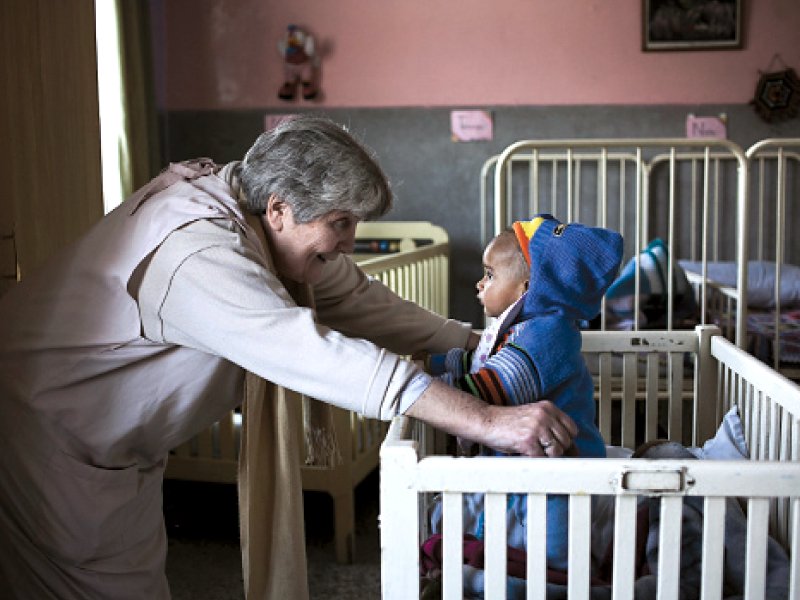
Lunch is announced at the St Joseph’s Hospice by the clatter of dishes, wheeled into the ward in perfect measure with the slight grumble that begins to settle in the children’s stomachs. The afternoon sun bounces within the pink walls of the room, painting their faces aglow while Sister Margaret Walsh watches from the corner of her eye and the children quietly eat.
Sharp and spirited, 22-year-old Ayesha is paraplegic and has spent over a decade at the St Joseph’s hospice, where she receives physiotherapy daily. While she has recovered some function of her hands, Ayesha is accustomed to being pampered by friends at mealtime; today is the first day that she has chosen to eat on her own, and for Sister Margaret Walsh, these are the little moments that define her days, and make her believe that while the books may not look so good, the 50-year-old hospice will certainly endure.

Few knew about the hospice — unassumingly tucked away in Westridge, Rawalpindi and identified largely as “the Christian hospital” by locals when summoned for directions. When news of its financial strain first spread, support was instant and overwhelming. The ensuing challenge, however, lies in seeking a sustainable income stream that can push the hospice out of the inherent uncertainty.
“We are exploring different ideas at the moment to broaden our income stream but without compromising on our ethos,” shared Lucy O’Donoghue, a member of the management committee. “We want to channel the wonderful support we have gotten over the last two months into sustainable measures.”
The building, though modest, is wrapped amid a sun-kissed garden. Raised from concrete and stone, the hospice comprises three separate wards for men, women and children within its two-storeyed structure.

An outpatient clinic brings in some revenue, with charges as little as rupees 20 per token but most are unable to afford even as much.
“We are deliberating over the idea of serving the community more widely,” shared O’Donoghue, explaining that offering physiotherapy, occupational therapy and respite care to the larger community could help bring in a regular stream of income.
“We have also carried out an energy order, to assess our utility expenditure, which account for almost 15 per cent of our expenses,” according to O’Donoghue, the recommendations of the evaluation are being implemented, which includes replacing lights with more efficient ones.
Earlier in the month, a staff meeting called in to discuss possible reductions related a sense of chivalry that has allowed the hospice to endure in some part through donations — which have dwindled in the last few years in the face of increased religious marginalisation, and the rising cost of food and electricity — and largely through the dedication of it’s staff, who opted to have their salaries reduced in order to retain all their colleagues.
“They may not have the best of training prior to their hiring, but their hearts are in the right place,” expressed Sister Margaret.
For 20-year-old, Sunil, who is a ward attendant, it is the sense of family that keeps him rooted to St. Joseph’s. While dealing with patients is often frustrating, the staff sees great reward in it.
Founded by Father O’Leary, who led the Franciscan Mission of Mary to Pakistan in 1962, with the vision to look after the ailing, the hospice has depended on donations for much of its tenure.
According to O’Donoghue, under 30 per cent of expenses were reliant upon private donations and voluntary work, though with rising costs maintaining fundraising efforts has proved to be a difficult task.
The new board of members, however, consists of a dedicated group of people with specific skills, including the technical expertise required to keep the hospice afloat, and its spirit, unrelenting.
“We should not be complaining, and so we are learning to help ourselves,” expressed Sister Margaret, “People came out of nowhere to our support when they heard about our difficulties, and we want to invest this help to become self-sufficient.”
Currently, the hospice is in need of including some new furniture and a paint-job and more wheelchairs for its patients.
Published in The Express Tribune, March 7th, 2014.
COMMENTS (1)
Comments are moderated and generally will be posted if they are on-topic and not abusive.
For more information, please see our Comments FAQ









































Come on all you Pakistanis let's contribute some donations to this great cause. The millions of foreign remittance coming from abroad screams the words....."Hey lady & sahib can you spare some rupees"lets kickstart from here every person reading this article can happily contribute for your brother or sister receiving care at this wonderful hospice.